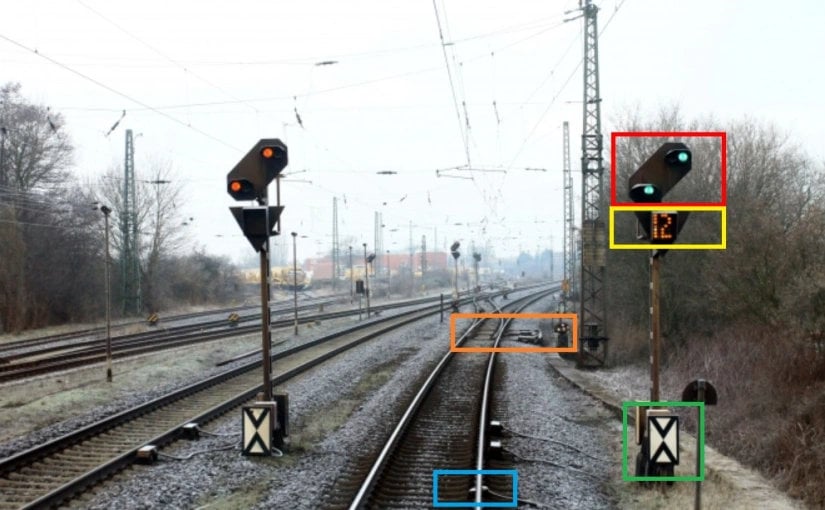railway-international.com
05
'23
Written on Modified on
Signal facial recognition, the Alstom’s ARTE project
Alstom is currently tasked with its research project ARTE (Automatisiert fahrende Regionalzüge in Niedersachsen), which is taking place in Lower Saxony and focuses on automated driving based on optical signal and obstacle detection.

The aim of this research project is to make automated driving possible in low regular regional traffic in Germany.
It is at present taking a step further. Together with the Technical University (TU) Berlin and the German Aerospace Centre (DLR), Alstom is exploring the possibilities of automating regional traffic via the European Train Control System ETCS and the implementation of the ATO.
Automate on existing line
The ultimate goal of the Lower Saxony trials is driverless operation. This includes signal recognition, in order to be able to recognise and interpret the signals and railway signs placed on the line. But why keep side signalling?
The special feature of the ARTE project is that it operates GoA 3 traffic on a line that does not have the required technology, but is only equipped with traffic lights. This is a very important argument that is of great interest to infrastructure managers, because unlike ATO programmes, it allows automation without touching the existing tracks.
This requires a system that can recognise and interpret these signals. As with obstacle detection, the challenges lie in bad weather conditions or in correct detection in blind spots, for example on track sections with a dense sequence of track signals.
Alstom has already shown with test trains in other countries that automated driving and remote control of trains can be technically implemented. While the train can be able to detect obstacles, it is planned that in the event of an incident, the train will be remotely controlled or guided by a trainman.
Facial recognition for railways could make people smile, but it should be remembered that object recognition technologies are precisely those used by the automotive sector or even Google in their research on autonomous vehicles. Facial recognition is now a relatively mature technology that allows for more advanced developments, including in railway sector.
EVC3 on-board technology
The ATO solution required for the research project will benefit from Alstom’s latest ETCS computer: the European Vital Computer 3 (EVC3). The EVC provides an ideal technical basis for the project. During the more than 20 years of evolution of this computer, an extremely high level of reliability has been achieved.
Alstom relies on its « Two out of Three 2oo3 » architecture, which is highly redundant. New functions, such as the future European radio system FRMCS (Future Rail Mobile Communication System), are scalably prepared in the EVC3. In addition, the latest generation of EVCs has reached a very compact size, for which a suitable installation location can easily be found in every conceivable vehicle.
Detection
The ARTE project is also testing the use of sensors that detect obstacles and signals. In particular, the obstacle detection, relocation and signal detection subsystems will be investigated.
Specifically, the aim is to address a number of challenges that the system should solve autonomously in the future. These challenges range from poor visibility conditions (fog, rain, night) to correct route recognition at track junctions and possible obstacles.
From automation level GoA 3 onwards, the ATO system must be able to detect obstacles in front of the train and within the train gauge. The obstacle detection system is responsible for perceiving these obstacles and providing the data to the ATO system.
Technically, the system should be able to safely detect obstacles with a surface area of 0.25 m² at a distance of 300 metres. As the distance increases, it becomes more difficult to correctly detect an object and its exact position. In automated railway operations, the detection of signals is taken care of by the system.
Role of the partners
For the introduction of automated rail operations in the regional area, DLR (the German Aerospace Center), is to identify both the operational requirements of the technology to be used in the future and the necessary adaptations to the vehicle currently operated manually (in this case the Alstom iLint railcar, which is already powered by hydrogen).
In addition, the researchers will investigate, with the help of railway operation and economic calculations, how the automation solutions can be applied to other regional lines. The aim is to derive recommendations for action for their equipment.
In addition, it is to be determined whether the existing regulatory framework should be adapted to automatic operation. Then the tests and results necessary to satisfactorily prove automated driving and its safety in normal operation will be examined.
Finally, the TU Berlin (Transport University), will implement the operational specifications. In this process, issues concerning the implementation of ATO in the control operation and in the fallback level are taken into account.
In collaboration with the partners, a detailed analysis of the differences in operation, technology and roles compared to the current operational service is developed and broken down into requirements for personnel and technology. Job descriptions and qualification approaches for the operating personnel will be defined and the corresponding training for driverless operation will be accompanied.
Author : Frédéric de Kemmeter www.mediarail.wordpress.com

